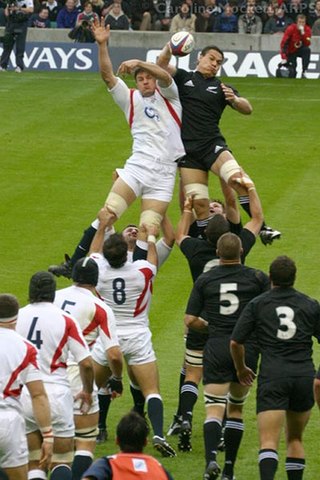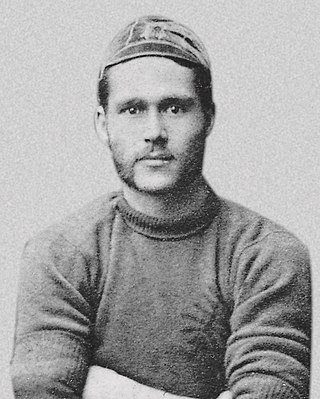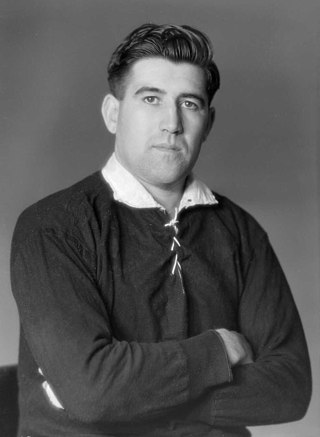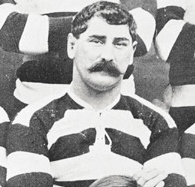
The New Zealand national rugby union team, commonly known as the All Blacks, represents New Zealand in men's international rugby union, which is considered the country's national sport. Famed for their international success, the All Blacks have often been regarded as one of the most successful sports teams in history.

New Zealand Rugby (NZR) is the governing body of rugby union in New Zealand. It was founded in 1892 as the New Zealand Rugby Football Union (NZRFU), 12 years after the first provincial unions in New Zealand. In 1949 it became an affiliate to the International Rugby Football Board, now known as World Rugby, the governing body of rugby union for the world. It dropped the word "Football" from its name in 2006. The brand name New Zealand Rugby was adopted in 2013. Officially, it is an incorporated society with the name New Zealand Rugby Union Incorporated.

David Gallaher was an Irish-born New Zealand rugby union footballer best remembered as the captain of the "Original All Blacks"—the 1905–06 New Zealand national team, the first representative New Zealand side to tour the British Isles. Under Gallaher's leadership the Originals won 34 out of 35 matches over the course of tour, including legs in France and North America; the New Zealanders scored 976 points and conceded only 59. Before returning home he co-wrote the classic rugby text The Complete Rugby Footballer with his vice-captain Billy Stead. Gallaher retired as a player after the 1905–06 tour and took up coaching and selecting; he was a selector for both Auckland and New Zealand for most of the following decade.

Rugby union has been played in New Zealand since 1870 and is the most popular sport in the country as well as being its national sport.

The Original All Blacks were the first New Zealand national rugby union team to tour outside Australasia. They toured the British Isles, France and the United States of America during 1905–1906. Their opening game, on 16 September 1905, was against Devon whom they defeated 55–4. They defeated every English side that they faced, including a 16–3 victory over English county champions Durham, and a 32–0 victory over Blackheath. They defeated Scotland, Ireland, and England with the closest of the three matches their 12–7 victory over Scotland. The team's only loss of the tour was a 3–0 defeat by Wales at Cardiff Arms Park. A try claimed by winger Bob Deans was not awarded by the referee and later became a subject of controversy. However, Wales were generally considered the better team with the All Blacks playing particularly poorly in the first half of the game. They managed narrow wins against four Welsh club teams and went on to play France in France's first-ever test match. They returned to New Zealand via North America where they played two matches against Canadian teams. Overall they played a total of thirty-five matches, which included five Tests, and only lost once—the defeat by Wales.
Charles Kesteven Saxton was a New Zealand rugby union and cricket player, coach and administrator.
The Cavaliers was an unofficial New Zealand rugby union team which toured South Africa in 1986. Because of the Apartheid policies of the South African government, the official New Zealand Rugby Union tour scheduled for 1985 was cancelled, and the Cavaliers tour was very controversial in New Zealand.

The 1888–89 New Zealand Native football team was a New Zealand rugby union team that toured Britain, Ireland, Australia and New Zealand in 1888 and 1889. It mostly comprised players of Māori ancestry, but also included some Pākehā. A wholly private endeavour, the tour was not under the auspices of any official rugby authority; it was organised by New Zealand international player Joseph Warbrick, promoted by public servant Thomas Eyton, and managed by James Scott, a publican. The Natives were the first New Zealand team to perform a haka, and also the first to wear all black. They played 107 rugby matches during the tour, as well as a small number of Victorian Rules football and association football matches in Australia. Having made a significant impact on the development of New Zealand rugby, the Natives were inducted into the World Rugby Hall of Fame in 2008.

Joseph Astbury Warbrick was a Māori rugby union player who represented New Zealand on their 1884 tour to Australia and later captained the 1888–89 New Zealand Native football team that embarked on a 107-match tour of New Zealand, Australia, and the British Isles.

Thomas Rangiwahia Ellison, also known as Tom Ellison or Tamati Erihana, was a New Zealand rugby union player and lawyer. He led the first New Zealand representative rugby team organised by the New Zealand Rugby Football Union (NZRFU) on their 1893 tour of Australia. Ellison also played in the 1888–89 New Zealand Native football team on their epic 107-match tour, scoring 113 points, and 43 tries with the side.

James Hunter was a rugby union footballer who played for New Zealand's national team, the All Blacks. He played mainly at second five-eighth, although he could play any position in the backline. He played for Hawera Club before being selected for Taranaki in 1898 and the North Island in 1904 before his first All Blacks selection in 1905. He toured with the 1905 All Blacks that travelled to Great Britain, France and North America. After returning he continued to be selected for the All Blacks until retiring after the 1908 season.
1949 saw the second full tour of South Africa by a representative New Zealand rugby union team. The All Blacks achieved a record of 13 wins, 7 losses and 4 draws, and they lost the test series 4–0.
Colin "Col" Windon, was a rugby union player and soldier who captained Australia – the Wallabies – in two Test matches in 1951. By age 18 Windon was playing at flanker for his club Randwick in Sydney's Shute Shield. After serving with the Second Australian Imperial Force in the Pacific Theatre during the Second World War, Windon resumed his rugby career in 1946. He was first selected for Australia for their tour of New Zealand that year. Despite the Wallabies losing both their Tests on tour, Windon impressed with his play.

John Burns Smith was a New Zealand rugby union player, soldier, sportsman and baker. He was an All Black captain, and despite only playing nine matches is recognised as a great. His 26 appearances for the Second New Zealand Expeditionary Force rugby team, which toured the UK in 1946–47, earned him high praise. He also played for the New Zealand Māori, being of Ngāpuhi descent.

Keith Davis was a New Zealand rugby union player who played for both New Zealand and New Zealand Māori. He played for Auckland, and won the Ranfurly Shield in his first ever provincial game. After gaining All Blacks selection in 1952, Davis toured with the team to Europe and North America in 1953–54. He played extensively for New Zealand Māori between 1952 and his retirement in 1959; his time with the team included matches against both South Africa and the British Lions. Davis was awarded the Tom French Cup for Māori player of the year in 1952, 1953 and 1954.

Rugby union has a long history in New Zealand. Today, New Zealand holds tier one status with World Rugby.

George Nicholson was a New Zealand rugby union footballer who played for New Zealand – the All Blacks – between 1903 and 1907. He played club rugby in Auckland for the City club, before making his provincial debut for Auckland in 1901. After playing for the North Island in 1902, he was selected for New Zealand's tour of Australia in 1903 where he played in the All Blacks' first ever Test match – against Australia in Sydney. The following year he was selected for New Zealand when they played a one-off Test against the British Isles who were touring New Zealand; New Zealand's first home international. In 1905 and 1906 he was selected for the All Blacks tour of Europe and North America. This was the first New Zealand national team to tour the Northern Hemisphere, and played 20 matches during the trip, but did not appear in any internationals. After returning to New Zealand he switched clubs to Ponsonby in 1907, and that year played two Tests for New Zealand against Australia – his last matches representing his country. After retiring from rugby he was involved in the sport as a referee, selector and administrator. He was one of the last surviving members of the Original All Blacks, as the 1905 team was called, and was present at the 75th jubilee celebrating for the formation of the New Zealand Rugby Football Union in 1967.

George Alfred Tyler was a New Zealand rugby union player who represented New Zealand – the All Blacks – between 1903 and 1906. He played in New Zealand's first seven Test matches, including all five Tests on the pioneering Original All Blacks 1905–06 tour of the British Isles and France. He played club rugby for City in Auckland, and was selected for his province between 1899 and 1911. His brother Bill Tyler also played rugby for City and Auckland before switching codes and representing New Zealand at rugby league.

William Cunningham was a New Zealand rugby union player who represented New Zealand—known as the All Blacks—between 1901 and 1908. Most notably he toured with the Original All Blacks on their 1905–06 tour of the British Isles, France and North America. They were the first New Zealand representative team to visit the British Isles, and of their 32 matches there Cunningham played in 23. He played mainly at lock, and was added to the touring party due to his strong scrummaging ability. He played in three Test matches during the trip: against Scotland, Ireland and France, but did not play in the loss to Wales due to injury, the All Blacks' only defeat on tour.

Henry Kiernan, also known as Mickey was a rugby union player who played for New Zealand internationally, including in the side's first ever Test match in 1903. Playing at half-back he represented Wanganui from 1894 till 1899, when he moved to Auckland in 1900. There he continued playing provincial rugby for his new province until 1908.

















